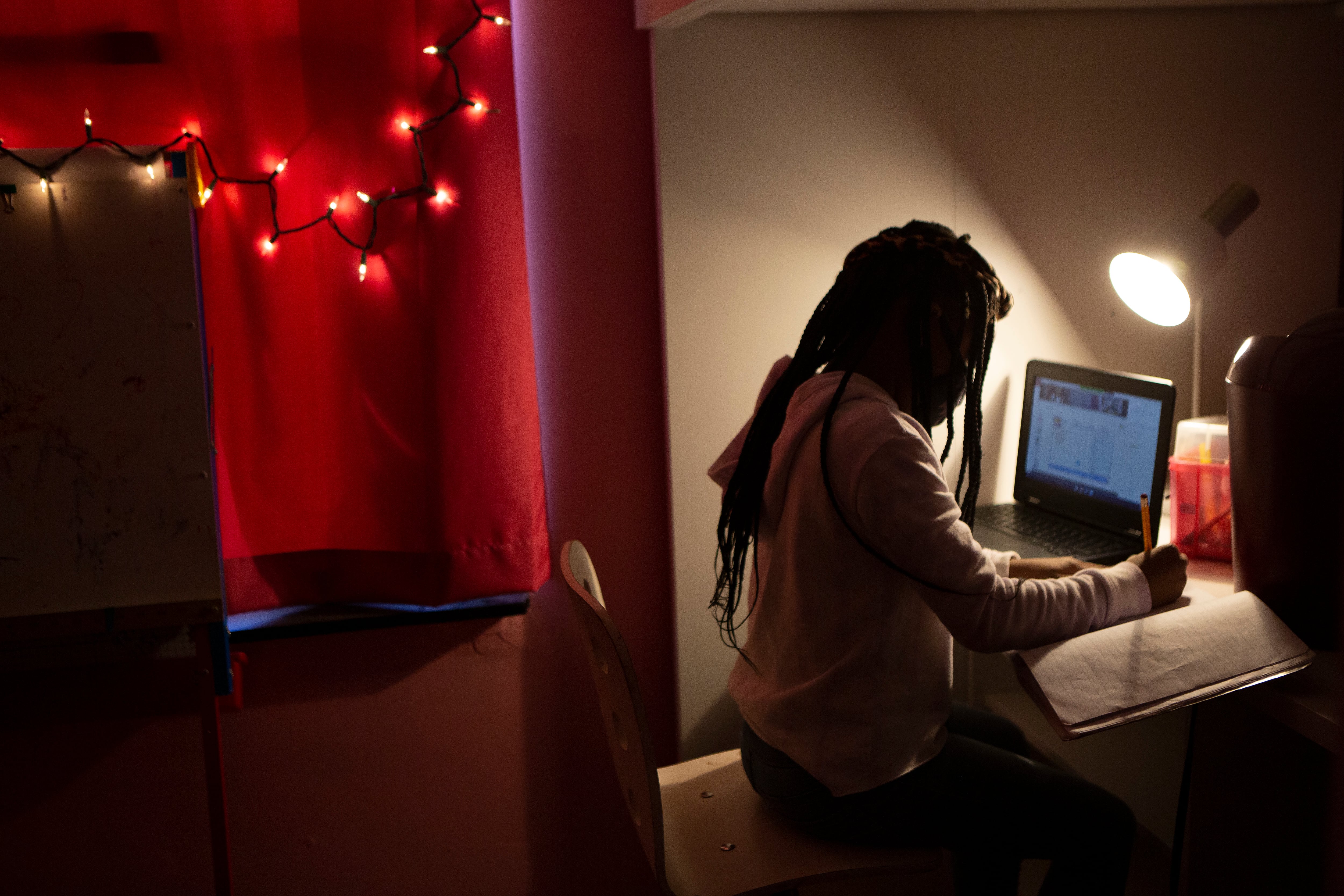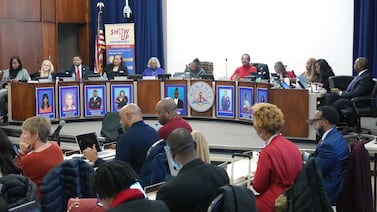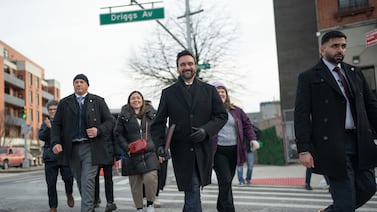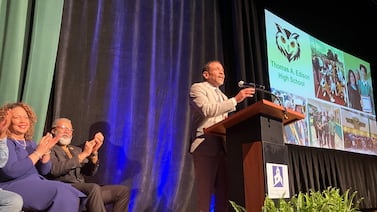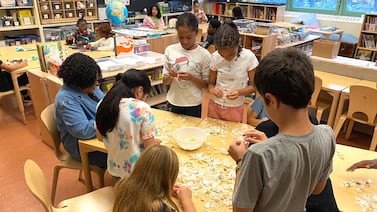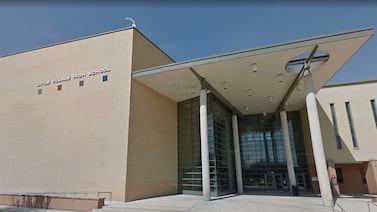As other Chicago Public Schools students donned masks and walked into school buildings for the first time in nearly two years in the fall, Gabriel Morser powered up his laptop to start seventh grade at the district’s Virtual Academy.
Inside his Northwest Side home, the 13-year-old felt a sense of calm even as delta and omicron surges disrupted in-person instruction for many students throughout the fall and winter.
“I feel a lot safer,” said Gabriel, who has asthma. “Because I’m kind of in my prime environment. I’m totally protected.”
Last fall, as school districts welcomed students back into classrooms, Chicago Public Schools – and other districts across the country – offered limited, remote instruction for children unable to return to school buildings amid the ongoing pandemic. Chicago’s Virtual Academy was set up to serve medically fragile students with a number of specific medical needs that include cystic fibrosis, spina bifida, leukemia, and asthma.
For about 420 students such as Gabriel, the Virtual Academy has offered a chance to focus on learning this school year without the specter of a potentially life-threatening bout of COVID. He says the instruction has been engaging, challenging, and tailored to his needs. Even as other districts have announced plans to do away with similar programs in the next school year, Chicago plans to keep that virtual option and offer a few more seats.
But as the district starts accepting applications for next year, information about how well the program has served students this year remains sparse. The lack of transparency has made it difficult to evaluate the program’s effectiveness, one union leader noted. Advocates and parents have raised questions about the curriculum and others familiar with the program said the Virtual Academy failed to provide adequate support for English language learners or meet the learning needs of children with disabilities.
In a statement, Chicago Public Schools said it was “evaluating” its “efforts during the first year of the program to determine necessary improvements, including improving communication with teachers, staff and students.”
Attendance data, obtained by Chalkbeat through a public records request, from the first half of the school year also shows students logged on at a much lower rate than for the district as a whole, and enrollment in the academy has fluctuated throughout the year.
“There’s not a lot of transparency around what’s happening with the Virtual Academy,” said Alex Kuske, an attorney for Equip for Equality, a nonprofit watchdog for people with disabilities.
Last summer, the district saw tepid interest in the program, with 150 applicants before extending its deadline. Some parents criticized the “confusing and chaotic” application process, lack of curriculum details, and uncertainty around whether the school would be able to support complex learning needs of students with Individualized Education Programs, a written education plan designed to meet the needs of students with disabilities, Chalkbeat reported at the time.
Of the 3,000 students determined to be eligible for the program, the district received 965 student applications. The district accepted 545 students and about 437 students were enrolled at the start of the school year, according to district figures. But student enrollment in the Virtual Academy has fluctuated throughout the year, district officials said.
For the first part of the year, elementary and high school level attendance at the high school lagged significantly behind the district, data shows.
Across the district, average student attendance was 94% in early September, compared to 84% among elementary students and 70% among high school students at the Virtual Academy. Attendance steadily increased in the months that followed, slightly surpassing the district average in late January during the height of the omicron surge, data shows.
Staff works to keep medically fragile students safe
Virtual Academy principal Wayne Bevis said staff has been working hard to accommodate the needs of families amid reopening.
“It’s been an amazing ride this year, setting up the school so that we can serve the medically fragile students of Chicago, and to keep them safe during this time of COVID,” Bevis said in an interview.
The Virtual Academy offers the same CPS curriculum for pre-kindergarten students while the school uses Edmentum, a curriculum designed for virtual learning, for kindergarten to 12th grade students. For students with disabilities, the school uses the Unique learning system curriculum modified for virtual instruction. All of the programs through the Virtual Academy, Bevis said, are aligned with Illinois education standards.
The school currently has 52 teachers, 25 special education aides, 12 bilingual special education assistants, and 12 support staff including the principal, clerks, counselors, and case managers, according to district figures.
Teachers, staff, counselors, and social workers are focused and committed to providing support and meeting the needs of students, Bevis said. He, along with the administrative staff, interact with parents on a regular basis to answer questions and get feedback from parents. They also have a bilingual advisory committee to address the needs of bilingual families and their students in the program, he said.
The aim is to “really learn about how we’re doing as a school and look for ways for improvement, because we’re always looking at how we can improve our services in our education for our students,” he added.
According to a survey of families, the principal estimates that about 90% of families have been satisfied with the program and plan to re-enroll in the coming year.
Bevis also noted the school was within 1% of the district average for medically fragile students, who typically have lower attendance due to the nature of illness and frequent doctor’s appointments.
For the Morsers, the program exceeded the family’s expectations and they plan to come back.
“A lot of people have been saying that they don’t think that students are being challenged while they’re in the virtual setting,” Taryn Morser said. “They are.”
Gabriel Morser explained that he felt “quite challenged” with teachers expecting more of students. “I’m doing high school level work and I’m getting like straight A’s from it,” he said.
His mother said the Virtual Academy was a blessing — one that has given her piece of mind regarding her son’s safety. “I know he is safe,” Taryn Morser said. “I know it’s not the petri dish like in a school.”
“It’s just been an amazing experience for both of us,” his mother added.
Parents are nervous about pushing back
But satisfaction with the program has not been universal.
Parent Katherine Buitron, a mother of three CPS students, saw early challenges with the Virtual Academy, starting with navigating the application process. Her sixth grade son, Matias, who has a medically complex diagnosis that includes primary immunodeficiency, cerebral palsy, asthma, and heart disease, was denied acceptance four times. He was ultimately accepted after multiple appeals.
“They made me jump through hoops, needles and red tape,” Buitron said.
Her other son and daughter, who are both over the age of 12 and had medical conditions including heart disease and asthma, were denied a spot in the academy, in part, because they were eligible for the vaccine, she says.
Parents and advocates expressed frustrations that siblings of eligible students were ineligible for the program. Those concerns intensified after the district moved to lift the mask mandate in March.
Buitron said she was “extremely upset” after learning her older children were not accepted. “I felt discouraged,” she said. “At that point, I even considered homeschooling my kids because we are talking about a matter of life and death with my youngest.”
Still, her older children returned to in-person learning while her youngest set out in the Virtual Academy. From the beginning, Buitron recalled classes being short-staffed and a failure to provide the additional support outlined in her son’s individualized learning program.
While her son isn’t an English language learner, Buitron joined the bilingual advisory committee to support parents’ whose children were not receiving English learning support.
During classes she found herself sometimes translating instructions to help parents who didn’t speak English. Two sixth grade classes were also combined because the school lacked enough staff.
“So at the very beginning,” she said, “there was a lot of scrambling.”
The classes were also hit or miss. In some classes, students had full teacher instruction, while in others, students watched YouTube videos for 45 minutes on which they would be tested, she recalled.
When her son started to have seizures from prolonged screen time, Buitron asked for paper copies of assignments to reduce Matias’ time in front of the computer. Parents were advised not to post concerns about the program on social media or go to the press, but instead to share their concerns with administrators, Buitron said. But after raising concerns with administrators without action, she took her son out of the program six weeks into the school year.
She homeschooled Matias for an additional six weeks before enrolling him back to in-person learning. After four days back in-person, he caught COVID-19 and landed in the ICU. He was later diagnosed with long COVID, she said.
Her son’s medical team has since created a modified schedule where he can return to school for part of the day. Still, she said the school year has been “extremely disruptive.”
Buitron has kept in touch with some parents who have said some of these issues persist.
Looking back, she said more accountability is needed for the Virtual Academy for the sake of the students and their families, especially for those considering enrolling their children for the upcoming year. “They’re failing everyone,” she said.
Parents who have signed up for the Virtual Academy are often “desperate to keep their children safe and out of brick-and-mortar schools,” or out of the district’s homebound program, which offers medically fragile students about an hour of instruction per day, said attorney Kuske.
Parents have been more flexible about what services they’re willing to accept with the Virtual Academy because the other options of returning to in-person or homebound aren’t “justifiable” options at the moment, Kuske said.
“To some degree, parents have been nervous about pushing back against the services their students are receiving because it feels to them like this is their child’s best option at the moment,” Kuske said.
In addressing questions about the curriculum, CPS said Edmentum was designed to provide teacher instruction equivalent to in-person. The Virtual Academy will implement Skyline schoolwide in the fall.
“Video clips may be used as part of both curriculums; videos are purposefully integrated into the curriculum, just like they may be used in the physical classroom at any school,” the district said.
It worked to adequately staff classrooms as more students were accepted into the Virtual Academy. In the event of a teacher vacancy, a substitute was put in place. The Virtual Academy staff also “worked consistently to meet the needs of Individualized Education Programs despite related service provider (RSPs) shortages,” the district said.
Bevis countered the claim about the combination of classes, saying the school made adjustments due to rapid enrollment at the beginning of the year to ensure English language supports were met.
“Parents have been asked to share their questions or concerns so we can address and resolve any issues,” the district said. “CPS actively encourages parents and students to participate in an open dialogue with administrators and staff at the Virtual Academy and throughout the District.”
What’s next for the Virtual Academy?
Last month, Virtual Academy announced applications for the upcoming year even as other districts nationwide are scaling back or getting rid of their virtual option
The Center for Reinventing Public Education (CRPE) found that less than half of the 94 urban districts with a virtual option for the 2021-22 school year had plans to continue the virtual offerings for the 2022-23 school year. A majority of those returning programs pre-date the pandemic, according to CRPE.
In Chicago, the district has made some changes for the upcoming year, including streamlining the application process and acceptance policy, which has been broadened for qualifying students based on school capacity. The Virtual Academy will also manage all inquiries and the acceptance process.
The Virtual Academy will also partner with high schools to increase advanced placement and dual credit courses. Elementary students will have access to Spanish and algebra lessons.
The application for next year is open until July 1, and acceptance will be announced by July 15. A lottery will determine placement if demand exceeds 550 applicants. Qualifying students who don’t get in will be placed on a waitlist, according to the district.
Still a year into the program, the district has released little information about the Virtual Academy, leaving many parents and community members with unanswered questions.
Union vice president Stacy Davis Gates said there is still little known about the first year of the academy. The CTU lobbied for a virtual option for medically fragile teachers and students ahead of full reopening. The union asked for teachers with medical conditions to be prioritized for the teaching positions at the program.
Asked about the percentage of school teachers hired with a medical condition for the program, the district said “all teachers and administrators at the academy applied via the normal CPS hiring process.”
It’s unclear how many teachers at the Virtual Academy have a medical condition.
“The Virtual Academy is a tool to be used during a pandemic,” Gates said. “Our ability to understand its use as an effective tool means that we need as much information in the selection process and the interim evaluation of how it’s going.”
CPS has leaned very heavily on principle autonomy and discretion, even with the Virtual Academy, which makes it difficult to evaluate the program, Gates said.
“There’s a lot we don’t know,” Gates said. “It’s been a black box.”
Correction: The article has been updated with the correct spelling of Wayne Bevis’ last name and with additional responses from the principal.
Mila Koumpilova contributed to this report.
Mauricio Peña is a reporter for Chalkbeat Chicago, covering K-12 schools. Contact Mauricio at mpena@chalkbeat.org.

